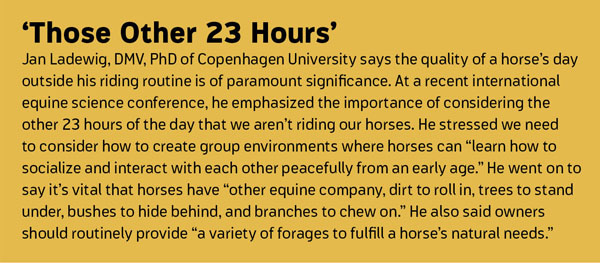Q I’ve had trouble locating boarding that offers a field with a run-in shelter. What’s the next best living arrangement for my horse?

LYNN INGALLS-BATES, Speedway, Indiana
A Unfortunately, horse owners often have to compromise as facilities and standards vary so much from place to place. Some boarding stables may be better in certain aspects of management than others, so it’s best to compare several places, weigh all the relevant options, and see which best meets your particular horse’s requirements. Remember, though, that a horse’s inborn needs to be physically healthy and mentally happy should have the edge over an owner’s desire to keep him as a hothouse flower.
While all horses are individuals, they must have their species-specific needs met. Studies have shown that domestic horses aren’t much different from wild or feral horses, mentally or physically. So from the horse’s point of view, the ideal boarding facility would have horses living outdoors 24/7 in mixed-sex groups. They’d have plenty of space to move and graze; access to clean, fresh water; and adequate shelter. It sounds relatively simple, yet it can be extremely difficult to find this ideal home for your horse.
More consideration should be given to horses’ welfare in the hours when they’re not being ridden and trained (see box). Their basic behavioral needs include “the three Fs”—friends, forage, and freedom. If these basics aren’t met for your horse, it can affect his health, behavior, and performance.
By nature, horses are social herd animals, so having equine company and the opportunity to socialize with others of their own kind is essential. In nature, they’d typically graze for approximately 18 hours and travel up to 100 miles a day, so access to daily turnout with grazing is vital. If good grazing is scarce where you are, then turnout with free access to grass hay is a good substitute.

Most stables will have variations of these management options—perhaps single-sex herds, individual turnout, or poor grazing. Try to find a place that offers those three Fs at least for a portion of each day. If you can’t find a stable that offers what you’re looking for, consider renting a field and sharing with other like-minded horse owners. You may even find it’s possible to erect the kind of shelter you’d like.
Some countries are now starting to recognize that horses need higher standards of welfare in their daily management to meet their behavioral and physical needs. The Swiss government has recently passed a law stating horses must be kept with other equines and have daily turnout. For the horses’ benefit, I hope this example will be followed elsewhere in the world.
JUSTINE HARRISON, CHBC, IAABC
Certified Horse Behavior Consultant
equinebehaviourist.co.uk






